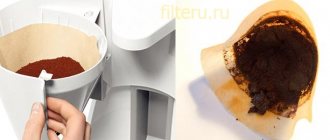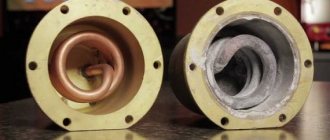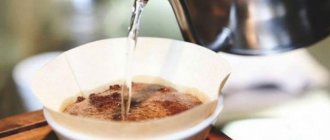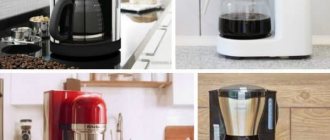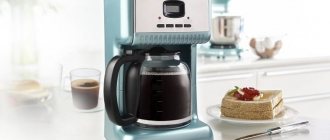How to increase strength?
Real filter paper, of course, is much stronger than an ordinary blotter, but it still sometimes breaks. Especially when you need to filter a large volume of liquid. The paper processing method proposed below increases its tensile strength by 10 times! At the same time, the filtering qualities do not deteriorate.
So, all you need to do is wet the paper with 70% nitric acid (density 1.42 g/cm3) and immediately rinse with plenty of distilled water.
After thorough washing, the paper should be dried and used as needed. Such paper does not introduce any contaminants into the filtered solution and is suitable for the preparation of medicines or use in analytical chemistry.
Paper treated in this way becomes so strong that a 5 cm wide strip of it can easily support the weight of a 1.5 kg weight. While ordinary filter paper breaks even at a weight of 150 grams.
Filter paper from different manufacturers has a pore diameter from 1.5 to 35 microns. At the same time, it is practically possible to purify liquids from impurities with a particle size of 1-2 nm (large pores in the paper become clogged, and filtration becomes finer).
The smaller the pore size of the paper and the greater the amount of sediment in the liquid being purified, the slower the filtration process. In some cases, you have to wait for hours for the process to complete. Progress is especially slow if the liquid has a high viscosity (something like syrup).
Making a carbon filter for water
To filter water, special industrial products are used. Their operating principle is identical. H2O is passed through special fillers, on which solid fractions, chemical and other compounds settle. The units are easy to use, aesthetically pleasing, and the final product is harmless to the body. The disadvantages are associated with the small volume of pumped liquid and the rapid failure of filters.
The way out of the situation is often associated with the independent production of filter devices.
The best option is to use carbon cleaners. Charcoal and activated carbon are used. In the first case, repeated cleaning of the absorbent is required (until the final removal of dust and small particles). Advantages:
- Effective retention of toxic substances.
- Removing unpleasant odor and taste from water.
- Creating a barrier to organic substances, including pathogenic bacteria and viruses.
- Hydrocleaned to a natural, clear appearance.
- Environmentally friendly.
- Long service life.
- No need for reagent washing.
Step-by-step instruction
Filter mechanisms operate on the same principle and are similar in design. A typical and common device is a 5 liter plastic bottle. Instead, it is possible to use a container made of another material.
Work order:
- The bottom is cut out in the container. This process is necessary for the convenience of pouring water. Other adaptations are acceptable. For metal products with small holes, pipe bends and funnels are used.
- Several holes are made in the bottle cap.
- The improvised body of the product is ready. It is mounted with the lid down in a stable position. The filtration process takes 3 hours. Therefore, the bottle is tied to a tree, chair, drainpipe, or attached to a stationary object. Under the filter there is a container for receiving clean water. If the action takes place in the field, then a bucket with a lid is used as such. A hole is drilled in it to insert the lid of a plastic container. Water is protected from dirt, dust, and foreign objects.
- Activated carbon is poured into the bottom of the product body. For a five-liter container, the layer thickness is 7 cm. If activated or charcoal is fractional, small particles are laid first, and larger fractions are placed on top.
- The coal is covered with sand. The thickness is 1-2 cm more than the coal layer.
- The created filter layer is covered with a five-centimeter layer of small, thoroughly washed pebbles.
- Water is passed through the filter to remove unrefined components.
The filter is ready for use. The volume of the container is selected depending on the purpose of the cleaning device. In offices, a liter bottle is sufficient. In private homes, 20-50 liter products are used to prepare drinking water.
Attention! If desired, the filtration layers are reinforced with gauze and special fabrics. To speed up the filtration process, layers of pebbles, sand, and coal are reduced
This method is used for rough water purification. Subsequently, it goes into industrial devices (cartridge consumption is reduced)
To speed up the filtration process, the layers of pebbles, sand, and coal are reduced. This method is used for rough water purification. Subsequently, it goes into industrial devices (cartridge consumption is reduced).
Fortels
Information was taken from various sources: the official website and the Tobacco Shop, etc.
BV Micres – The Mascotte Company is the most famous European manufacturer of sleeves, paper, machines and some other accessories for rolling papers.
Mascotte is the original brand of Mignot & de Block BV. This family business from Eindhoven (Netherlands) was founded back in 1858. The production of cigarette paper and filters takes place in France, Austria and Germany. Let's take a closer look at the products of this manufacturer at the moment.
1. Cigarette sleeves.
This is an almost finished cigarette (made of paper with a filter), but without tobacco inside. With their help, you can make your own cigarette - to suit your individual taste. At the same time, you will get great pleasure from smoking, compared to factory-made cigarettes. You choose your favorite tobacco, free from any impurities, fill the sleeve using a filling machine (machine) and enjoy the cigarette you made yourself. Mascotte cigarette tubes are made from specially made paper using a special technology developed since the 40s. An important condition for the quality of a branded product is that cigarette paper is not impregnated with nitrate, since the quality of this paper does not require catalysts for smoldering. Currently there are the following varieties:
— Classic (100, 200 or 250 pcs/pack)
— Gold Micro perfo filter. Excellent quality sleeves with a perforated filter for additional air circulation.
— Carbon. Activated carbon filter.
— X-Long Filter. Longer filter (filter length 25 mm) compared to standard sleeves (15 mm)
- Menthol. The filters in these cartridges have a fresh menthol flavor. Hermetically sealed packaging ensures that the menthol flavor remains fresh for a long time.
— Filters for rolling papers
Mascotte filters are one of the best on the world market, do not affect the taste of your tobacco, and are very convenient to use (thanks to the sticky edges made of gum arabic - a natural plant product without taste or smell). There are regular and coal, and also differ in diameter: standard (8 mm), Slim (6 mm) and Extra Slim (5.3 mm).
Extra Slim comes in regular length (15 mm) and X-Long (19 mm)
You can also find Slim filters with menthol
Not long ago, Slim and Extra Slim Filter Sticks began to be produced, in which the filters are packed in 6 pieces in cellophane film and you no longer need to clean the filters from tobacco crumbs by removing them from the pouch.
— Paper for rolling papers
An important factor in the manufacture of rolled-up cigarettes is the quality of the cigarette paper. One of the best on the world market is “Mascotte” rolling paper. Mascotte cigarette paper is the highest quality paper, it does not affect the taste of the tobacco you choose. Made from specially selected plant fibers.
If you hold a strip of paper (Gomme or Green) up to the light, you can see many microscopically small holes. These holes, applied electronically, make the rolled cigarettes extraordinarily soft, while preserving the taste of the tobacco itself.
The raw material for paper is natural textiles produced at the foot of the Pyrenees mountains; the paper does not contain wood cellulose additives. This is why cigarette paper curls, sticks and burns so easily.
The adhesive, applied in an almost invisible layer, is made on the basis of gum arabic, a natural plant product. Gum arabic is tasteless and odorless, both when smoked and when moistened.
Here are Mascotte's main papers:
MASCOTTE Gomme rolling paper is a pure and natural product, made from specially selected plant fibers, bleached without the use of chlorine. Density: 20 g/m2 Size: 70 mm
Green Cut-Corners is a pure and natural product, just like MASCOTTE Gomme, made from specially selected plant fibers, bleached without the use of chlorine. A thin layer of glue is made on the basis of gum arabic (a natural plant product). Just like MASCOTTE Gomme, MASCOTTE Green cigarette paper has many microscopically small holes (Laser Perforated). These electronically inserted holes make the cigarette extremely smooth while preserving the flavor of the tobacco itself. The main difference of this paper is the cut corners for easier rolling of the cigarette. Density: 17.5 g/m2 Size: 70 mm
Peculiarities
Water purification is a necessary measure of modern life, because the impact on nature of various factors of human activity has significantly affected its quality and purity. The best solution to this problem is filters that can be installed both at home and in an enterprise of any size.
Water purification in the filter is carried out by passing through a certain number of stages, and the more of them, the purer the resulting product will be. At the first stage of purification, mechanical filtration occurs, when large enough elements that clog it are removed from the water. The next stage involves influencing the chemical environment of the liquid, and the last level will be the carbon cartridge, passing through which the water becomes completely drinkable.
Most of the filter elements are cartridges, which have their own gradation:
- Mechanical. With its help, sand, mechanical suspensions, and rust are removed. Composition: polypropylene.
- Carbonic. Helps remove substances of organic and inorganic origin, removes unpleasant odors, and affects the color of water. Composition: activated or pressed carbon.
- Softening. Softening water by removing heavy metals from it. Composition – Na-cationic resin.
- Iron removal. Helps purify water from hydrogen sulfide, improve pH, eliminate metallic taste and odor. Composition: two fills of calcite.
Due to the variety of cartridges, they can be used for different functions, which, in turn, leads to the need to use different devices for this.
Jug filters are the most common option when drinking water is of poor quality. The way they work is very simple, and the price is not high, so almost everyone can afford this option. The filter media is a carbon cartridge that can only handle 500 liters of water before it needs to be replaced. There are specialized and universal options. Specialized ones have additions that make water softer by removing iron from it and adding fluoride.
Carbon cartridges are also installed in the faucet attachments. Their feature is the low water pressure that must pass through the pipes, otherwise the system will be ineffective.
Free-standing units do the job after they are connected to the water pipes with a flexible hose.
To disinfect water, it is best to use an ultraviolet filter, which can only be used after preliminary mechanical cleaning. In addition to regular drinking water, there is also rainwater, which can also be used effectively. Due to contamination, it is often unusable, but with the help of filters it can be used in a wide variety of areas and for any task. In this case, you need two filters - one primary, to filter out large debris, and the second, for more thorough filtration and obtaining usable water.
Making filters at home
The ability to make a filter for a coffee maker at home, from available materials, will always come in handy. It usually happens that the coffee maker stops working at the most inopportune time due to the fact that the filter needs to be replaced. As always, there will not be a suitable replacement in the house. Or, upon unpacking a new element, a manufacturing defect is discovered. Here the situation will be saved by a hastily made device from scrap materials.
From paper
Using paper to make a filter at home is the easiest way out. Paper napkins, towels, and even ordinary writing paper are perfect for this. But remember three basic rules.
- There should be no typographical marks. Do not use paper with text or designs printed on it. Printing products use substances that are harmful to health.
- The paper should not be very thick. This does not affect the quality of the process, but filtration through dense material will take a long time. And this worsens the taste of the resulting drink.
- Do not use soft or loose paper. In this case, there is a possibility that the filter, made of loose material, will quickly become unusable - it will simply fall apart.
Therefore, opt for medium-weight paper. It is recommended to take a few minutes and test the properties of the paper you are going to filter through. Just wet the paper and watch its characteristics change. Tests will show that it is better to use paper napkins and towels made of thick material. Typically, high-quality and expensive products are made from such paper. The material has many pores, so it perfectly retains large particles and allows water to pass freely.
From fabric
From school knowledge it is known that fabric has a filtering effect. As a material for such an element, you can use ordinary cotton fabric, as well as products made from it. Gauze, a bandage or a piece of an old sheet will work perfectly.
The ideal option would be to use white, undyed fabric. Any dye, even one that is safe for health, can give coffee a specific taste. Therefore, it is recommended to use either undyed or lightly dyed fabrics. A bandage or gauze will be more effective if you pre-fold it in several layers before use. Before using such materials, it is better to rinse them first, or even better, boil them. This will rid the coffee of the nasty “medical” smell of sterilizers.
From nylon
A well-known material for making a coffee filter is nylon. Most often, ordinary women's tights or stockings are used for this. Nylon allows water to pass through perfectly and will perfectly filter coffee grounds. Filters made from nylon can be used several times. Since modern stockings are made from various materials, you should first make sure that the stockings or tights you use are made of nylon. The main thing is to ensure that holes do not form in the material used.
Metal filter
Filters made from ordinary metal tea strainers will be more durable. Typically, such strainers are used to filter tea leaves immediately before pouring the drink into a glass. Such products have an aesthetic appearance, but the holes in them are very small. Therefore, strainers clog quickly. This increases the time it takes to filter the drink through such strainers. Coffee passed through such an improvised filter element loses its unique taste and aroma.
Why do you need a water purification device?
Jug-shaped filters are already included in the list of basic kitchen interior accessories. They will do a great job if you need to filter a couple of liters of liquid. But when it comes to large volumes, pocket and household devices are useless and you have to look for a commensurate alternative.
A properly assembled filter is quite capable of purifying tap water, but it’s better not to drink it right away, but to let it sit for a while
A suspension of sand, fine clay particles, organic matter, waste products of all types of animals and microorganisms makes water from open reservoirs categorically unsuitable for drinking. The situation is the same with wells.
The agricultural industry annually becomes on par with the heavy and chemical industries in terms of pest levels, due to the amount of nitrates used. Thus, the use of nitric acid to fertilize the soil saturates groundwater with harmful salts.
Be that as it may, even the most modern equipment periodically needs to replace cleaning cassettes, let alone homemade ones. After a certain time, it is imperative to replace the makeshift system with a specialized one.
This is important to do because the water may contain pathogenic bacteria and other undesirable microflora, which are absolutely impossible to filter, and only the sanitary and epidemiological station can cope with bacteriological contamination of a river or well. To make a simple water filter, you only need an Aquaphor cartridge.
The device is enough to clean approximately 179 liters
To make a simple water filter, you only need an Aquaphor type cartridge. The device is enough to clean approximately 179 liters
Types of filters for coffee makers
Let's look at different classifications of filters.
- Reusable filters for coffee makers . From the name it is clear that such devices can be used repeatedly and are usually included in the basic configuration of the coffee maker. On the one hand, they are convenient because they help you save money, because you can use the device for a long time.
On the other hand, they require careful handling and keeping them clean, otherwise the growth of bacteria and the appearance of an unpleasant aroma from the drink cannot be avoided. Reusable devices are divided into two types - nylon and gold.
The first is nylon filters for coffee makers . Equipped with a plastic case, which is covered with synthetic nylon. Such a device needs frequent cleaning and rinsing, otherwise you will soon notice an unpleasant odor. Among the advantages, it is worth noting the cost-effectiveness of use, the possibility of long-term use with careful handling. But this option is only suitable for coarsely ground coffee, and in no case for powdered coffee.
The second is gold filters for coffee makers . More advanced than nylon “competitors”. Their surface is coated with titanium nitride, which makes the device more durable and of higher quality.
Cellophane
Yes Yes! An ordinary plastic bag in which they put two hundred grams of sausage for breakfast at the supermarket! Of course, to create a light filter we need a clean, unused bag. But is it really a problem to find one on your farm? A light filter from an ordinary plastic bag can be used to simulate an overexposed frame (the so-called light leak effect). Or you can color the cellophane in one way or another.
So, we take cellophane of any color we like. We cut off a piece of the size we need and use an elastic band to attach it to the lens of our camera. That's all, actually. Our filter is ready for use. Look through the camera viewfinder to see if the piece of cellophane is lying flat. Smooth? Let's start filming!
With such a cellophane filter you can cover the entire lens, or you can cover half of its front lens or even a small part. You can make a combination of pieces of cellophane of different colors. To obtain an interesting and unusual effect, you can generally glue together some kind of grid from cellophane of different colors. Everything here depends on your imagination, taste and sense of proportion. What if you use cellophane of different thicknesses? Different structure? Should it be placed closer or farther from the front element of the lens? What if you draw, for example, multi-colored lines, circles or other shapes on cellophane with a felt-tip pen?
Imagine! Try it! Just keep in mind that such a homemade filter reduces the sharpness of the image to one degree or another.
Wine glass
Are you surprised? But this is true. The most ordinary wine glass can serve as an excellent light filter to achieve simply stunning photographic effects! Let's first fill a glass with clean water and look through it. Thanks to an optical phenomenon called refraction, in a glass we will see an inverted image of what is behind it.
Photographing through a wine glass filled with water can create a wonderful series of photos!
How to take photographs with such an unusual filter? It's not difficult at all. We place a glass filled with water in front of the lens on some plane (table, chair, window sill, on a stump in the forest...), focus and start shooting. You need to focus on the image that will be visible on the surface of the glass. We recommend this type of shooting in aperture priority mode. The aperture needs to be opened wider. A wide open aperture allows us to get shallow depth of field, which in turn allows us to get good foreground sharpness while keeping the background nicely blurred.
Well, after you finish the photo shoot through a wine glass filled with water, in the process of post-processing the image on the computer, the picture can be turned 180 degrees, that is, in other words, put it upside down. Now, from the point of view of human perception, the image will be correct.
Glowsticks
Another very original way to get an interesting and unusual photographic image is to use glow sticks when shooting. They will add a colorful rainbow to your pictures. Portraits taken this way are especially interesting. To create this “light filter”, glow sticks need to be activated and attached in front of the lens, lengthwise or crosswise, as you wish. You can use one stick or several. Experience shows that the smaller the glow sticks, the better the effect they give in the photo.
The easiest way to attach glow sticks to the lens is with adhesive tape.
This must be done very carefully. At the same time, try not to damage the lens or dirty its front lens.
Don't forget to also ensure that the glow sticks attached to the lens do not interfere with your ability to rotate the zoom ring and the focusing ring.
Well, here are all the types of original and unusual light filters that we wanted to tell you about today. Of course, your camera, equipped with such unusual accessories, may cause smiles from others. But, you see, your main goal is to get interesting and unusual photos! What is more important to you? The end result or the reaction of your friends to the process of your work? Decide for yourself. Let us just note that in the old days, some photographers, instead of Vaseline, used... the contents of their own nose, applied to a neutral density filter screwed onto the lens. Yes Yes! They will pick their nose with their finger, and then wipe their finger not on a handkerchief, but on a light filter.
What are the types of filters and their functions?
Their main function is to clean the ground coffee during the brewing process. And it is the quality of this filter that can make a significant difference in the final result, namely the aroma and taste of the drink itself.
Let's delve a little into history. The coffee filter was invented back in the last century by an ordinary housewife from Dresden. She used a simple schoolboy's blotter and folded it into a funnel shape into which she poured the coffee.
She placed this structure over a cup, and then slowly began to pour boiling water. This way, an aromatic and tasty drink was obtained, while all the coffee grounds remained on a piece of paper.
In the modern world, this principle has remained unchanged, but it is now used in coffee machines. Moreover, progress does not stand still, so today the materials from which these filters are made also differ. Below we will take a closer look at the most popular options.
Why do you need a filter for a coffee maker?
The principle of operation of the system is simple. Water poured into a closed container evaporates during the heating process. Following the laws of physics, water vapor flows up the outlet tube, at the end of which it condenses. It is believed that the temperature of the condensate obtained in this way is optimal for preparing the drink. Through a filter into which pre-ground coffee beans are poured, the condensate enters the final container. This will be freshly brewed coffee. The quality and taste of the drink depends on the filter element. Therefore, manufacturers are developing new products, promising improved taste. At the same time, the cost of products increases every time.
Filter sizes
If you want to purchase a ready-made filter for a coffee machine, then when you come to the store, you will see that their sizes vary from 1 to 12. And when choosing, the size is the main criterion, since if it does not match, the filter cannot be used for a particular device.
So, the size must clearly match the size of the bowl in the coffee machine. For example, if a pourover has an inscription with a size of 0.1, then filters must be purchased with exactly the same designation. Typically, filters of size 02-04 are suitable for drip coffee makers. And if you want to use this product to brew coffee in a cup, then you should give preference to a smaller size.
Their peculiarity is that they can be used for any coffee machine. They are usually sold in packs of 100 disposable filters.
However, some experts and coffee lovers argue that universal filters are a waste of money, since they not only fail to cope with their main task, but can also have a negative impact on the functionality of the coffee maker by clogging it.
How to replace the filter in a coffee maker - do it yourself
If you did not have time to buy a new filter, and the old one can no longer be used, you will have to resort to improvised means.
To make a paper filter for a coffee maker with your own hands, you can take the following materials at hand:
- Plain paper. Make sure in advance that it allows water to pass through,
- Paper napkins or towels,
- Cotton and chintz fabric, for example, from an old sheet. Determine by eye how many layers it needs to be folded - one or two.
- Gauze bandage folded several times. Before first use, you should rinse it thoroughly in water to get rid of the specific odor.
- An exotic option is to use women's tights, since nylon retains impurities well and at the same time allows water to pass through.
But you shouldn’t get carried away with homemade devices, this is more of a one-time way out of the situation, because such devices are not able to fully cope with the task, so do not forget about the timely purchase and replacement of filter elements.
Sand filter for pool
As already mentioned, the process of constructing small-sized variations of filter systems is quite simple, however, if we are talking about a large reservoir, it is necessary to think through all the nuances of the purification system.
Many people have probably encountered the problem of “blooming” water. Most often, this process is observed in the warm season, and if the pool is also equipped with a heating system, such an incident can occur at any time.
It’s fair to say that the problem of green water can be completely solved by improvised means, namely, removed mechanically, but sometimes a layer of algae can sink to the very bottom and removing the surface film will not solve the problem.
In addition, not only algae can act as a pollutant, but also fallen leaves, as well as sand and all kinds of microparticles if the pool is located outside. Faced with problems of this kind, people begin feverishly buying all sorts of detergents and cleaning products, in the hope of getting rid of annoying green islands. But the active chemical action of substances can only help with the pollutant that is on the surface and in order to clean the tank to the very bottom, completely different methods are needed.
To completely clean the pool, there are special filter systems. They work on the principle of a “vacuum cleaner”, namely, they pump liters of contaminated liquid through a compressor. The filtration process is a repeated transfer of water from one part of the pool to another. This mechanism is often used in large municipal or private institutions, where the volume of the pool sometimes reaches thousands of liters, so the best solution is an automated filtration system.
But it is not profitable for the average user to invest in such bulky equipment if, for example, it is necessary to clean only a small seasonal inflatable tank.
Just for such reservoirs there are instructions for constructing a sand filter.
The body of the device contains a filler with filtering properties (sand). You can replace the material with any other
During the assembly process, you will need any container that can serve as a cartridge. The water tunnel from the primary filter can be made from a plastic pipe 2 meters long (if the pool is large).
You also need to take into account that the tunnel design involves a 90-degree rotation, so a PVC corner is needed. The inner diameter of the cartridge and pipe should be about 50 mm.
A threaded bushing with a diameter of M10 can be used as a support pin for cleaning modules. The convenience of this design allows you to connect several filter cassettes into one, which turns a regular filter into a multi-level one. This increases the absorption efficiency and, as a result, the water becomes cleaner. At the first stage, you need to make two holes (it is better to use a hammer drill).
The first is in the filter plug, and the second is in the PVC corner, then connect the two parts using a pin and nut. A water compressor should be attached to the other end of the tube. The power of the equipment should be selected based on the volume of the pool.
In order for the filter to float, it is necessary to make a special foam backing.
The purification process is circular, and occurs by taking water from the lower layers of the pool and pumping it through the filter using a pump.
The advantage of this design is the absence of additional elements for releasing filtered water, as well as the possibility of replacing the cartridge. It is better to carry out the rinsing procedure over a separate container to avoid dirty liquid getting back into the pool. It is better to use a bucket for this.
In addition, the cost of this installation is significantly less than branded analogues. Everything you need can be purchased at specialized retail outlets, for example, a compressor is sold in any pet store, PVC pipes and corners in construction supermarkets, and a replacement cartridge in the markets in the plumbing department.
A big advantage when creating a floating filtration system is the freedom of design. If you have decorative components on hand, you can disguise the filter as any object that fits into the composition of the pool, for example, a ship.
A selection of videos showing how to properly make a filter for your weed joint.
Some marijuana smokers include a whistle on their joint, others do not. However, even if you are used to doing without it, we recommend that you at least once try to hammer a joint with a filter.
Find out what's great about the filter in your joint, then start watching the video!
The filter helps the joint retain its shape!
A filter - no matter whether purchased or homemade - will prevent your joint from falling apart. It also helps with rolling the joints by giving you something cylindrical to wrap the paper around.
This also means the joint won't bend or break when you shake off the ashes!
A joint with a whistle is harder to smoke!
In my opinion, there is nothing worse than receiving a joint that has been passed around in a circle and is practically dripping with saliva. It is clear that, being equipped with a whistle, the joint will not turn into a disgusting slobbering something so quickly!
Better traction!
By making a high-quality filter with sufficient holes for air movement, you will provide your product with smoother draft. In a joint without a filter, the cannabis crumbs clump together in some places, making it difficult for the smoke to pass through.
Not a crumb of grass will be wasted!
Without blowing the whistle, you will find that there will always be some cannabis left at the end of the cigarette butt. It will have to be poured out of this joint and hammered into a new one. And there will be another “bull” and so on ad infinitum.
Make a filter and you can smoke ALL the cannabis in your joint!
Wide variety of filters...
A whistle can be much more than just a cylinder of cardboard. There are ready-made filters on sale, including reusable ones and even wooden ones that can be inserted into a joint.
Sometimes in a package of rolling paper there are special strips from which you can twist filters, or you can take any “left-handed” piece of thin cardboard, and it will serve just as well.
Maybe you have your own secrets and tricks that you are ready to share? Write in the comments!
Subscribe to our Telegram channel and you will be promptly informed about new publications on the website: https://t.me/KannaBizz
Source - Herb.co
You may also be interested in
Planokuram: 10 life hacks against fawning and other bummers
What do they say about someone whose imagination knows no bounds? - Dude, what are you smoking? Man in general is an inventive creature, and even more so the planokur. He will always find a way to provide himself with buzz, .
Are filters for rolling papers necessary or not? The debate about this can go on seemingly endlessly. Some lovers of rolling cigarettes claim that with a filter the taste of tobacco is significantly lost. Others, on the contrary, never do without this element.
So, how advisable is it to use filters for rolling cigarettes? In our article we will analyze everything on this topic: why filters are needed, what they are, and how to make them yourself.
Common problems when using homemade filters
All these methods are suitable only for temporary replacement of filters from the manufacturer. In addition, it should be remembered that these options are mainly suitable for one-time use, as otherwise they require careful cleaning.
And yet, homemade devices are not able to completely clean the drink from coffee particles, and the final result differs significantly from those filters that are sold in hardware stores.
Therefore, always stock up on filters for your coffee maker, and if you don’t have such an accessory, don’t despair, because you can always make one at home without much expense, both in terms of finances and time.
How to make a filter for a drip coffee maker with your own hands
What to do quickly when faced with the need to replace the filter, and the supply at home has run out? You can easily solve this problem at home.
The simplest material you need for this is paper.
Important: Before you begin, you need to check the quality of the paper when exposed to water. A material that is too dense will increase the filtration time, and low-quality loose cellulose will simply “fall apart” upon contact with boiling water and will not be able to make coffee.
Also, do not use paper with printing ink and glue, or photographs; this will significantly spoil the drink and may even harm your health.
Thick white or brown napkins or paper towels are convenient in this case.
The last option is the most successful, since the towel is highly porous, so it quickly lets through
The last option is the most successful, since the towel is highly porous, so it quickly allows water to pass through, and retains large particles of coffee well. We also note that filters of any size can be cut from a towel.
For example: take a saucer and trace it on a piece of towel. Using scissors, cut out a square or circle, fold it in half, and then in half again. Pour ground coffee into this homemade filter and insert it into the funnel and then into the cup. Slowly pour boiling water through the prepared structure and get an aromatic and invigorating drink.
If you suddenly don’t have high-quality paper at hand, you can use a fabric option - a bandage, a cotton towel, gauze or a sheet.
An important detail: the fabric used should not be dyed, since otherwise, when exposed to hot water, “tasteless” chemical dyes may be added to the drink.
We recommend taking a clean medical bandage or gauze. Just be sure to rinse the material thoroughly before brewing to prevent a medicinal aftertaste from the prepared drink.
For more thorough filtration, fold the gauze in several layers.
A very interesting option for making a filter element would be to use nylon women's tights as a material.
A cut out square or circle from tights will be a wonderful coffee filter. In addition, it can be used several times.
Also on the list of homemade products are metal strainers from teapots. The obvious disadvantage of using them is their small size and poor throughput. These strainers usually become clogged with coffee mixture very quickly and therefore require constant cleaning. Fans do not recommend preparing coffee in this way - the drink turns out unsaturated and unflavoured.
